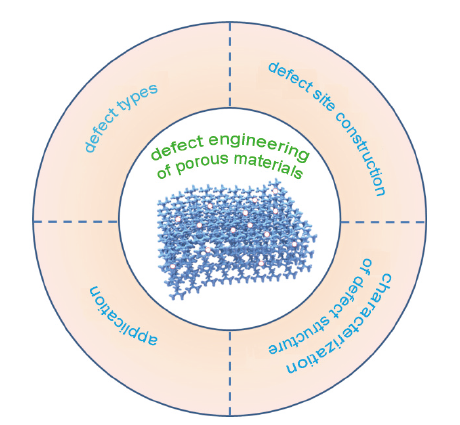 PDF(17545 KB)
PDF(17545 KB)


Condensed Matter Chemistry: The Defect Engineering of Porous Materials
Yuenan Zheng, Jiaqi Yang, Zhen-An Qiao
Prog Chem ›› 2023, Vol. 35 ›› Issue (6) : 954-967.
 PDF(17545 KB)
PDF(17545 KB)
 PDF(17545 KB)
PDF(17545 KB)
Condensed Matter Chemistry: The Defect Engineering of Porous Materials
Condensed matter chemistry is mainly concerned with the multilevel structure, chemical properties and chemical reactions of various states of materials, and frontier scientific issues in condensed matter construction chemistry. Porous materials with high surface area and adjustable pore structure, show great potential in a variety of applications. With the continuous exploration of defect engineering strategies for porous materials, the research scope of condensed matter chemistry has been greatly expanded. In the construction of defect sites and the functionalization application of porous materials, condensed matter chemistry permeates every process. The formation and regulation of phase, pore structure and defect sites involved in the synthesis of defective porous materials and the effective transformation of guest species on surface active sites in performance application, which fully reflects various chemical reactions, surface and interface interactions between the microstructure of porous materials and different species in condensed matter chemistry. This paper takes defective porous materials as the research object to discuss, including the suitable inorganic porous materials for defect engineering strategies, the types of defect structures in porous materials, the construction and regulation of defect sites of porous materials in condensed matter chemistry, the characterization of defect sites in porous materials, and applications of defect-rich porous materials in the field of energy storage and catalysis. In is desired to deepen the understanding of porous material defect engineering from the perspective of condensed matter chemistry, and it is expected to further promote the development of functional porous materials under the guidance of condensed matter chemistry.
1 Introduction
2 Porous materials suitable for defect engineering
3 Defect types of porous materials
3.1 Vacancy defect
3.2 Doping defect
3.3 Other type defects
4 Construction methods for defect engineering of porous materials
4.1 In-situ synthesis method
4.2 High temperature heat treatment method
4.3 Chemical reduction method
4.4 Vacuum activation method
4.5 Other methods
5 Characterization method of defect structure in porous materials
5.1 Micromorphology characterization
5.2 X-ray photoelectron spectroscopy
5.3 Raman spectrum
5.4 Electron paramagnetic resonance spectroscopy
5.5 Synchrotron radiation X-ray fine structure spectrum
6 Applications of defect-rich porous materials
6.1 Effect of defect engineering on porous materials
6.2 Application of defect-rich porous materials in catalysis and energy fields
7 Conclusion and perspective

condensed matter chemistry / porous materials / mesoporous materials / defect engineering
| [1] |
|
| [2] |
|
| [3] |
|
| [4] |
|
| [5] |
|
| [6] |
|
| [7] |
|
| [8] |
|
| [9] |
|
| [10] |
|
| [11] |
|
| [12] |
|
| [13] |
|
| [14] |
|
| [15] |
|
| [16] |
|
| [17] |
|
| [18] |
|
| [19] |
|
| [20] |
|
| [21] |
|
| [22] |
|
| [23] |
|
| [24] |
|
| [25] |
|
| [26] |
|
| [27] |
|
| [28] |
|
| [29] |
|
| [30] |
|
| [31] |
|
| [32] |
|
| [33] |
|
| [34] |
|
| [35] |
|
| [36] |
|
| [37] |
|
| [38] |
|
| [39] |
|
| [40] |
|
| [41] |
|
| [42] |
|
| [43] |
|
| [44] |
|
| [45] |
|
| [46] |
|
| [47] |
|
| [48] |
|
| [49] |
|
| [50] |
|
| [51] |
|
| [52] |
|
| [53] |
|
| [54] |
|
| [55] |
|
| [56] |
|
| [57] |
|
| [58] |
|
| [59] |
|
| [60] |
|
| [61] |
|
| [62] |
|
| [63] |
|
| [64] |
|
| [65] |
|
| [66] |
|
| [67] |
|
| [68] |
|
| [69] |
|
| [70] |
|
| [71] |
|
| [72] |
|
| [73] |
|
| [74] |
|
| [75] |
|
| [76] |
|
| [77] |
|
| [78] |
|
| [79] |
|
| [80] |
|
| [81] |
|
| [82] |
|
| [83] |
|
| [84] |
|
| [85] |
|
| [86] |
|
| [87] |
|
| [88] |
|
/
| 〈 |
|
〉 |